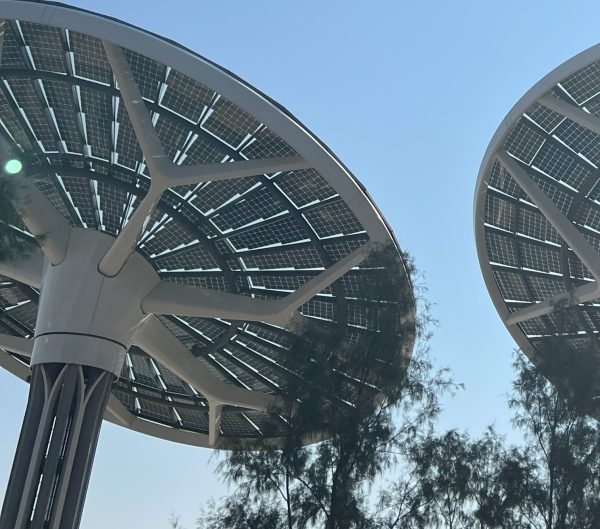
Image credit Hannah Case – Solar Panels in Dubai Expo
Written by Rhiannon Biddiscombe and Juan Garcia Valencia (SCENARIO DTP students)
On the first day of COP28 $430m was pledged to the Loss and Damage fund. But how will this money be allocated to the people who need it most?
What is the Loss and Damage Fund?
The Loss and Damage (L&D) Fund is a landmark agreement aiming to protect the world’s poorest and most vulnerable from climate-driven natural hazards, including wildfires, flooding, and drought.
At the beginning of COP28, five countries and the EU pledged around $430m to the L&D fund. In their short introductory speeches, many world leaders noted the success of finally putting resources into the fund. However, this is far less than the fund’s annual target of $100bn by 2030.
In a study published earlier this year, a pair of researchers identified that at least $140bn of damages are caused globally each year by extreme weather events linked to climate change. This cost is expected to become larger as global temperatures increase and extreme weather events become more damaging. This demonstrates the need to properly finance the L&D fund and even increase its funding goal to help developing countries mitigate and recover from natural hazards made worse by climate change.
The deal aims to assist developing countries in mobilizing external finance to respond to the dangers posed by climate change. The fund will support both the achievement of international goals on sustainable development and the eradication of poverty.
The L&D fund finances will be administered by the World Bank and decisions on allocating funding will be made by the L&D board. This board is made up of representatives from 24 nominated countries, a majority of which are developing nations from different geographical regions. This structure amplifies the voices of resource-limited countries suffering the most from the impacts of climate change.
How is funding allocated and what is it used for?
To access this fund, developing countries submit an application outlining the hazards and climate threats they confront. The L&D Fund not only serves as a financial resource, but also offers expert guidance, assisting countries in presenting compelling cases. This includes expert advice, provided by the Santiago Network, a group organised by the United Nations, comprised of organisations which specialise in minimising and averting loss and damages resulting from natural hazards. This will ensure the allocated funds are utilized most efficiently and effectively. Recipient countries then have the flexibility to monitor and make adjustments based on their evolving needs.
The L&D board will aim to allocate funds to the countries most vulnerable to climate change related hazards. The need for the just allocation of funding was highlighted by the French President, Emmanuel Macron, saying L&D funding “must go to the poorest countries above all”.
Assessments will be made based on cost-of-recovery estimates from national and regional bodies, while also focussing on scientific data such as IPCC (Intergovernmental Panel on Climate Change) reports and the knowledge of affected indigenous and vulnerable communities.
What are some problems with the mechanisms for L&D?
On the second day of the event, heads of state and on-site representatives have voiced concerns and raised issues regarding the mechanisms and structure of the L&D Fund.
Notably, President Ursula von der Leyen of the European Commission emphasized the need to bolster the fund, as current estimates of annual loss and damage are thought to be greater than $400 billion and steadily increasing. In addressing this financial challenge, she advocated to “reform the international financial system”, create a “stronger green bonds market”, and implement “more carbon pricing”.
A sense of apprehension was felt on the ground as the World Bank was announced as the host of the fund for the next four years. Concerns have been voiced by developing nations and indigenous groups regarding their ability to access the fund under the current operational framework given the lack of transparency the World Bank typically adheres to. This concern ties into a larger problem articulated by leaders of local communities at COP, noting a significant disconnect and misunderstanding between government’s priorities and local community needs. Frequently, issues remain unaddressed, and financial resources fail to reach the areas where they are most urgently needed.
The New Collective Quantified Goal, a climate finance system currently in negotiation, is set to be fully arranged in the near future. This UN-led project aims to further encourage investment from developed countries into climate-resilience across the globe, sharing the burden of cost associated with the climate crisis. As part of this initiative, developed nations will be mandated to provide money to a wider set of funds which includes the L&D fund, with a minimum finance level of $100bn per year. Seeing how long it has taken to establish and finance the L&D fund, the New Collective Quantified Goal may provide hope for better funding, or could simply be the next bargaining chip in intergovernmental negotiations.
What does this mean for COP28?
The establishment of the L&D fund marks a successful start to COP28. It addresses the unequal distribution of climate change impacts felt by countries which have emitted the least, providing them access to the finances of more developed countries to protect from climate-based hazards. As COP28 continues, we can hope for increased contributions from developed nations to empower the L&D fund to provide the best assistance to the groups who need it.

